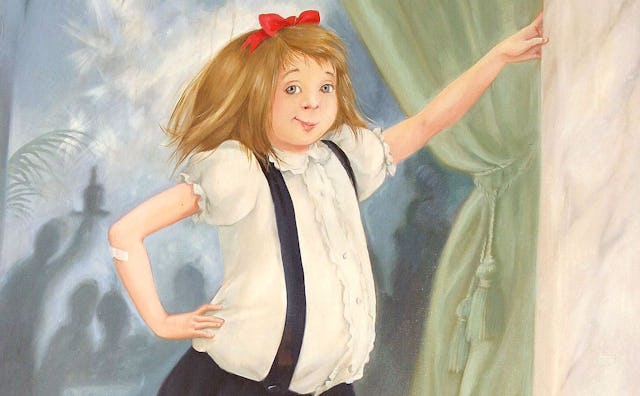Lena Dunham and the Original Precocious Girl: Eloise

I’m too old for it, but I like Girls because Lena Dunham is at its center. Not because the plots are relevant to my current experience (I’m a wife and mother). Not because I need a conduit for youth culture (firehosed with it daily, who craves more youth culture?) or handmade hipsterism (living in Brooklyn, I’m nearly asphyxiated by preciousness).
I watch it because she’s a good writer, and I like her character Hannah’s preoccupation with remaining a Creative Person. I like that she looks up at the ceiling when she talks to people. I like that Hannah peddles pretentious crap as often as she mocks it—as do lots of us at every age. I like that she’s panicked about being exposed as a fraud, but confident too. Having probably behaved like a jackass while getting my MFA, I devoured Hannah’s workshop scenes in Iowa—laughing, cringing, recalling my own feats of imbecilic thoughtfulness.
I watch it because it doesn’t matter that I’m past the casual sex, the thrills, the indignities and heartbreaks specific to being a woman in her twenties. Now my indignities (rogue hair sprouts) and joys (staying home at night on my couch) are those of a woman much older than Hannah. But I want to continue knowing what’s in Dunham’s head. It’s funny and smart and phobic in there. I’m drawn in not because of her relationships or neuroses or pleated pants, though those things compel me, but because of her development as an artist and a woman.
When a writer can do what Dunham can—see herself from a distance, sharply critical but tender, and think ahead to some future perception of self—the results are powerful. As long as she does this, I’ll be interested in her projects—most recently an HBO documentary she executive produced with Jenni Konner. It airs on March 23rd and is called “It’s Me, Hilary.”
The film, directed by Matt Wolf, is about Hilary Knight, the illustrator of the iconic Eloise books written by Kay Thompson. It explores the total collapse of the creative and personal relationship between Knight and Thompson, and the terrible after-effects of this divergence for Knight. It’s a story most fans of the book probably aren’t aware of. Dunham appears in it and we learn about the formative influence Knight’s illustrations had on her.
© Will Ragozzino/Getty
In addition to a childhood fascination—she has an Eloise tattoo on her lower back and talks about feeling kinship with a character who “doesn’t care that her stomach hangs over her skirt”—Dunham’s interest in making a film about Knight, I’m assuming, is intertwined with a desire to create a portrait of an artist—one that was as young as she was when he first earned major success. Look what can happen, I felt as though she might think, even when you are talented and full of promise, if something goes wrong. The psychology of worrying—so familiar to me now in middle age—that good things can be taken from you. Knight makes clear that something vital was taken from him.
Now 88 years old, witty, weird, and making films in his backyard, Knight feels thwarted, but that there’s much left to do. His collaboration with Thompson, the success of the book, and their ugly parting of ways makes for a melancholy narrative about the clash of two artistic people. We learn that Thompson was such a “powerhouse personality” and so vice-grip controlling, that Knight felt as though he “dissolved into the background” in her presence. She was all the things he was not, but he masterfully transferred his emotions into the drawings. As time passed, many felt that Thompson resented Knight’s images being as identified with Eloise as much the text—something she ultimately refused to abide.
Dunham says it was as if “two people got divorced and were fighting over their child, Eloise.” To Knight’s profound regret, he signed documents early on that prohibited him from ever drawing Eloise, or anything that looked like Eloise, apart from Kay Thompson. Even after Thompson’s death, contentious dealings with her estate made his involvement fraught on additional Eloise projects. Despite a career illustrating other books, gorgeous theater posters, and his desire to continue working, Knight has never duplicated the success of Eloise.
In the film, Fran Lebowitz puts a hopeful point on his life’s work. Though it was frustrating and unfair to be stiff-armed out of Eloise’s world, she says, “He made something that lasted. Almost nothing lasts. He made a beautiful thing that endures, and that is really rare.”
I’d imagine this idea is meaningful to an over-achiever, and a fretter, like Lena Dunham, who explains revealingly that her love for Eloise as a child came from recognizing a character with “a sense of place, and a sense that she deserves to be where she is.”
Indeed. As an artist who has received her share of attention and admiration, it feels as though Dunham wanted to make a film honoring another deserving artist who has not received his. And perhaps, never will.
This article was originally published on